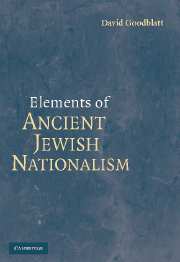Book contents
- Frontmatter
- Contents
- List of Abbreviations
- Preface
- 1 Theoretical Considerations: Nationalism and Ethnicity in Antiquity
- 2 Constructing Jewish Nationalism: The Role of Scripture
- 3 Constructing Jewish Nationalism: The Hebrew Language
- 4 A Kingdom of Priests: The Priestly Component in Ancient Jewish Nationalism
- 5 Israel Nationalism
- 6 Judah Nationalism
- 7 Zion Nationalism
- 8 Conclusions: Jewish Nationalism – What Rose and What Fell?
- Bibliography
- Author Index
- Index
7 - Zion Nationalism
Published online by Cambridge University Press: 20 July 2009
- Frontmatter
- Contents
- List of Abbreviations
- Preface
- 1 Theoretical Considerations: Nationalism and Ethnicity in Antiquity
- 2 Constructing Jewish Nationalism: The Role of Scripture
- 3 Constructing Jewish Nationalism: The Hebrew Language
- 4 A Kingdom of Priests: The Priestly Component in Ancient Jewish Nationalism
- 5 Israel Nationalism
- 6 Judah Nationalism
- 7 Zion Nationalism
- 8 Conclusions: Jewish Nationalism – What Rose and What Fell?
- Bibliography
- Author Index
- Index
Summary
The use of the name “israel” by the rebels of 66 and 132 is understandable in the light of ancient Hebrew literature and the precedent of the pre-exilic Kingdom of Israel. The use of the name “Judah” (or its Greek and Latin equivalents) by the Hasmonean and Herodian rulers also had biblical warrant and the precedents of the Kingdom of Judah and the Persian, Ptolemaic, and (presumably) Seleucid provinces of Judah. In this chapter we look at another name that may have served to denote or invoke ancient Jewish nationalism. This is the name “Zion.” The evidence is limited, but – especially in view of modern history – tantalizing. The first clue comes from the bronze coins of the first revolt. As noted earlier, one side of these coins bears dates of year two through year four. Some of the year four issues also bear denominations of “half” or “quarter” on the same side that has the date. For all three years of issue the opposite side of the bronze coins has a legend mentioning “Zion.” In years two and three the inscription is “freedom of Zion.” In year four it is “for/of the redemption of Zion.” The mention of Zion is both unprecedented and unparalleled in ancient Jewish numismatics. The name did not appear on Persian, Ptolemaic, or Hasmonean era issues, nor was it used later on the coins of the revolt of 132–5.
- Type
- Chapter
- Information
- Elements of Ancient Jewish Nationalism , pp. 167 - 203Publisher: Cambridge University PressPrint publication year: 2006

